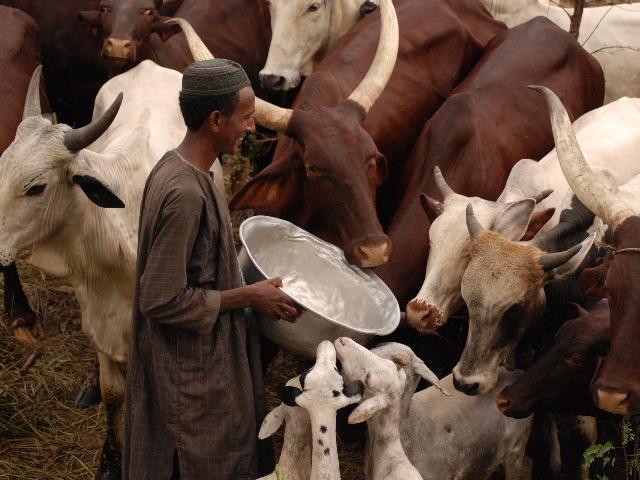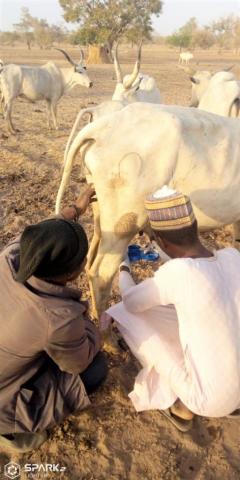How Fulani pastoralists in Nigeria are fighting back against mastitis and antimicrobial resistance
Measures to prevent infections aim to reduce antibiotic use and improve milk production
By Ciara Vance and Jeimmy Suarez-Martinez

In central Nigeria, Fulani pastoralist Adamu is worried about one of his cows. She has been lethargic, is not grazing much, and has produced less milk lately. She is also in pain – at milking she kicks him whenever he touches her swollen, hard, painful udder. But he must keep milking her; he needs what little milk she produces, even though it is now watery and contains blood clots. Adamu recognizes these symptoms; he sees this all too often in his herd. His cow has mastitis. Adamu knows what to do: he will treat her with antibiotics.
Adamu and his neighbours have no access to a vet or health officer. Without professional advice on treatments, he turns to his community. After all, this is a well-known disease amongst the herdsmen and many know first-hand the devastating impact it can have on their cows, milk production and income. Fortunately, somebody he knows offers to sell him some antibiotics. This is a relief as there are no veterinary pharmacies nearby.
Adamu injects his sick mastitic cow with the antibiotics. He may not know the name or type of antibiotic he is giving her, but he is thankful to have something that may stop the infection.
After a few days’ treatment with the antibiotic, Adamu’s cow seems to be improving. The swelling in her udder has reduced and she has not kicked him for the past two days! Sadly, this joy is short-lived, and the mastitis returns. As always, Adamu wonders what he did wrong. Did he use the incorrect antibiotic? Maybe he should have injected more or carried on for longer? Perhaps the antibiotic was a fake? He doesn’t know, and without veterinary input he never will. But he cannot give up on his cow or his livelihood. And with that Adamu sets off to get advice from the local herdsmen again….. hopeful the next antibiotic he tries will work better.
Obstacles
Adamu is a fictional character, but the challenges he faces are based on evidence provided by real Fulani herdsmen. In early 2020, Supporting Evidence Based Interventions (SEBI) interviewed pastoralists from Plateau State in central Nigeria on mastitis management and antimicrobial usage and we used their responses to form the narrative of our story.
- Around one third of herdsmen interviewed (31%) did not know the name of the antimicrobials they were using to treat their mastitic cows. Of those that did, the most commonly used were tetracyclines (oxytetracycline and long acting tetracycline), tylosin and penicillin.
- When it came to deciding which antimicrobial to use, over half (57%) followed the advice of their fellow herdsmen, with far fewer receiving vet or animal health officer input (30%).
- Their main challenges to treating mastitis were identified as a lack of access to animal health providers and/or lack of medicines (64%).
- More than half the respondents (53%) reported recurrence of mastitis after treatment with antibiotics.
This survey highlights the misuse of antibiotics to treat mastitis in dairy cattle. The overuse of antibiotics, incorrect doses or duration, or using the wrong antibiotic can be counterproductive, and help bacteria become more resistant. The antibiotics to treat mastitis may stop working and animals will not respond to treatment at all. There is also a risk that these antimicrobial resistant bacteria will be passed from cattle to humans through direct contact, the food chain and/or the environment. Increased antimicrobial resistance (AMR) is a global problem which has a direct impact on animal health and potentially human health.
But without access to veterinary advice, laboratory diagnosis and quality animal health products, many pastoralists like Adamu are forced to continue diagnosing and treating their own animals, potentially contributing to AMR.
Reducing Antimicrobial Usage
Mastitis is the most common disease of dairy cows and one of the most common reason why cows are treated with antibiotics. If we can prevent mastitis infections occurring in the first place then we can reduce antimicrobial usage. Over the past year Supporting Evidence Based Interventions (SEBI) has been working closely with Livestock Extension Officers (LEOs), Fulani pastoralists in Nigeria’s Plateau State, and the Nigerian National Veterinary Research Institute (NVRI) on mastitis prevention and early diagnosis.
Better training and education
The key to mastitis prevention lies in good husbandry, hygiene, management and milking practices. SEBI trained several Livestock Extension Officers from Plateau State, Nigeria in mastitis prevention and control, and these LEOs went on to train over 300 Fulani pastoralists. As well as face-to-face workshops, educational materials on mastitis management, such as training manuals and videos have been prepared. These are freely available and they have been designed to be translated into different local languages.
- Video: Mastitis in smallholder dairy cows - Introduction
- An introduction to mastitis in smallholder dairy cows.
Access to dairy hygiene products

One of the most effective tools in preventing mastitis are post-milking teat dips. These solutions help form a barrier over the teat end, reducing the number of mastitis-causing bacteria entering the teat from the environment. Since teat dips are not commercially available in Nigeria, SEBI has imported several tonnes so that pastoralists could trial the product. The trial was successful and demand for the product has grown. In response, SEBI is currently facilitating the first registration teat dips and sanitizers in Nigeria in collaboration with Turner Wright Ltd of Nigeria and Rumenco Group UK.
Access to diagnostic tools
Early diagnosis of mastitis can prevent the disease from escalating into a severe clinical case requiring antibiotic treatment. One indicator used to diagnose mastitis is the somatic cell count (SCC) of milk. The higher the SCC, the more severe the infection level. As part of our work a Somatic Cell Counter was imported and commissioned for use at the National Veterinary Research Institute, the first SCC counter of its kind to be installed at the institute. In addition, the LEOs and pastoralists were introduced to the California Mastitis Test (CMT), a cowside test which can be used to indicate levels of SCC in milk. We’re currently working to produce locally manufactured CMT fluid, providing a cheap and sustainable alternative to importing commercial products.
What’s next?
By working closely with national government and industry partners, and by listening to Fulani pastoralists like Adamu, SEBI scientists have helped establish a better understanding of the issues around mastitis, and used this to shape a package of solutions. Now, local partners and businesses will take on the management and implementation of these interventions, to ensure a sustainable, long-term strategy to curb mastitis, improve animal health and productivity in Nigeria and to help reduce AMR.
Ciara Vance is a Project Manager with Supporting Evidence Based Interventions (SEBI). Jeimmy Suarez-Martinez is a Researcher with SEBI. This programme is awarded to The Royal (Dick) School of Veterinary Studies at The University of Edinburgh.

